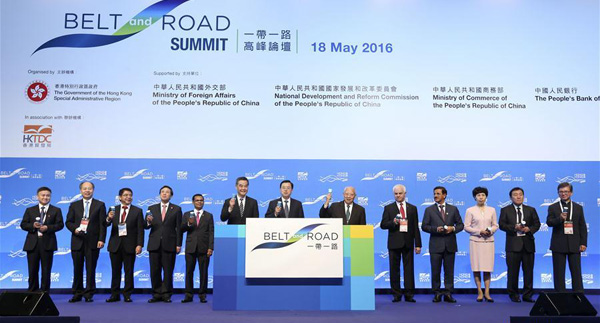Hong Kong has unique advantages for participation in Belt and Road Initiative: Top legislator

HONG KONG, May 18, 2016 (Xinhua) -- Zhang Dejiang (C), chairman of the Standing Committee of China's National People's Congress, attends the opening ceremony of the Belt and Road Summit sponsored by the government of Hong Kong Special Administrative Region (SAR), in Hong Kong, south China, May 18, 2016. (Xinhua/Pang Xinglei)
HONG KONG -- Top legislator Zhang Dejiang said here Wednesday that the Hong Kong Special Administrative Region (SAR) has its unique advantages for participation in the Belt and Road Initiative.
"This summit on the Belt and Road takes place in Hong Kong not only because Hong Kong is a Special Administrative Region of China, but also because it is a key link for the Belt and Road," Zhang told the Belt and Road Summit sponsored by the Hong Kong SAR government.
In designing its 13th Five-Year Plan and the Vision and Actions for the Belt and Road, the central government has made it a major policy to support Hong Kong's participation in the Belt and Road development, said Zhang, chairman of the Standing Committee of the National People's Congress.
Hong Kong will be able to make important contribution to this endeavor as it has its own geographic and cultural advantages, he said.
The Hong Kong SAR also serves as a first mover in opening-up and cooperation and a professional service hub, Zhang added.
The Silk Road Economic Belt and the 21st Century Maritime Silk Road Initiative, proposed by China in 2013, is aimed at reviving the ancient trade routes that span Asia, Africa and Europe.
In terms of maritime transport, Hong Kong sits on the busiest international sea route and boasts developed port economy. It is also an important gateway in the landscape of China's opening-up, Zhang said.
On the land, Hong Kong is next to Guangdong province. With modern means of connectivity, Hong Kong has easy, efficient and economic access to China's mainland, thus serves as a hub of transportation and international communication. In terms of air transport, Hong Kong has the world's busiest international airport, topping the list in passenger and goods transport.
"Hong Kong borders on the Pearl River Delta, one of the three economic growth poles of China and the pioneer of China's institutional and structural reform and the country's pursuit of innovation-driven development," Zhang said.
Hong Kong is next to Shenzhen, a center for innovation and entrepreneurship. As a natural partner, Hong Kong can join forces with China (Guangdong) Pilot Free Trade Zone, the Qianhai Shenzhen-Hong Kong cooperation zone and Fujian province, which is a core area for the 21st Century Maritime Silk Road.
Hong Kong's strength in the service sector and that of its neighboring provinces in manufacturing have great potential in exploring the international markets.
As a free port from the very beginning and the world's freest economy for 22 years in a run, Hong Kong maintains close economic and trade relations with most countries and regions in the world, he said.
"After the return of Hong Kong to the motherland, an all-round, wide-ranging and high-level form of exchange and cooperation between the mainland and Hong Kong has taken shape."
According to Zhang, many opening-up policies of the mainland were first experimented and practiced in Hong Kong.
"This offers a good foundation for Hong Kong to seize new opportunities arising from the Belt and Road Initiative and achieve new progress."
Hong Kong is a developed economy with a diverse and advanced service sector, an important international financial, shipping and trade center with the world's largest offshore RMB market, and one of the world's most favorite places of arbitration.
"In accounting, law, consultancy, tourism, infrastructure development, engineering design and other fields, Hong Kong may offer a variety of services to countries along the Belt and Road routes," Zhang said.
Noting that Hong Kong has been an important window for cultural exchanges between the East and the West and for interaction among various civilizations for decades, the top Chinese legislator said it has created a distinctive culture that integrates the Chinese and Western civilizations.
Southeast Asia is an important region for Belt and Road development thanks to people-to-people connections. Lots of ethnic Chinese went there from Guangdong via Hong Kong in the early years, and many ethnic Chinese doing business there have their origin in Guangdong, which like Hong Kong, is part of the Cantonese culture circle.
"This laid down the cultural foundation for deepening exchange and cooperation," said Zhang.
- Chinese president appoints new ambassadors
- Top legislature schedules upcoming session in October
- China's top legislator meets Liberian senate president pro tempore
- China's top legislator meets Cambodia's National Assembly president
- China urges Group of Friends of Neutrality members to reform and improve global governance



